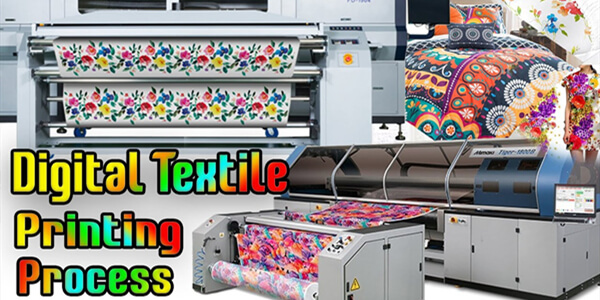
Digital Printing Technology and Its Application in Textile Dyeing and Printing Industry
I. Introduction
Digital printing technology is a modern method that uses digital techniques to print designs onto various substrates, including textiles. This technology has revolutionized the textile industry by providing an efficient and cost-effective alternative to traditional printing methods.
The importance of digital printing technology in the textile industry cannot be overstated. This technology has made it possible to print high-quality designs with intricate details and vibrant colors onto fabrics in minutes. It has also eliminated the need for extensive prepress and setup processes required in traditional printing methods, resulting in faster turnaround times and reduced costs. As a result, digital printing technology has become an essential tool for textile designers and manufacturers, enabling them to create unique and custom fabrics that meet the demands of today's consumers.
II. Process of Digital Printing
Digital printing involves a three-step process: pre-treatment of fabric, inkjet printing, and post-treatment of printed fabric.
A. Pre-treatment of fabric Before the fabric is printed, it undergoes pre-treatment to ensure the ink adheres well to the fibers. The purpose of pre-treatment is to block the fiber capillaries, promote the binding of the dye to the fiber in a moist and hot state, and resolve issues such as fabric curling and wrinkling. This process improves the quality of the printed fabric.
B. Inkjet printing is the core process of digital printing technology. The printer sprays ink onto the fabric to create the desired design. Digital printing allows for high-quality printing with intricate details and vibrant colors. In this process, the composition of the paste plays a crucial role. It includes components such as paste, alkali (soda ash), urea, sodium hexametaphosphate, and other elements, each with a unique function.
C. Post-treatment of printed fabric After the ink has been printed onto the fabric, post-treatment is necessary to fix the dye to the fibers and improve the color fastness of the fabric. Post-treatment includes steaming, washing, and drying. Washing removes any excess dye and chemicals from the fabric, and drying ensures that the fabric is ready for use. Steaming is critical to ensure the dye is fully fixed to the fabric.
III. Importance of Fabric Pre-treatment
Fabric pre-treatment plays a crucial role in digital printing as it prepares the fabric for printing. The pre-treatment process involves several steps, including scouring, bleaching, and steaming, to ensure the fabric is clean and ready for printing.
One of the most important benefits of pre-treatment is blocking the fiber capillaries of the fabric. This prevents the ink from spreading too much on the fabric, creating a blurry or undefined image. Pre-treatment also improves the dye-fiber bonding, ensuring the printed image is durable and resistant to fading.
Another benefit of fabric pre-treatment is resolving issues of fabric curling and wrinkling. Fabrics can curl or wrinkle during the printing process, affecting the final print's quality. Pre-treatment can minimize these issues and ensure the fabric remains flat and smooth during printing.
Overall, fabric pre-treatment is a crucial step in the digital printing process as it helps to ensure that the fabric is ready for printing and that the final print is of high quality and durability.
IV. Role of Ink in Digital Printing
Ink is a critical component in digital printing, and its composition plays a significant role in achieving high-quality prints. The ink used in digital printing generally consists of paste, alkali, urea, and sodium hexametaphosphate.
The paste serves as the main vehicle for the dye, helping to transfer it onto the fabric. Alkali, such as sodium carbonate or bicarbonate, is added to the ink to adjust the pH level, which affects the dye's solubility and fixation. Urea helps to improve the ink's stability and prevent clogging of the printer head. Sodium hexametaphosphate, a dispersing agent, is added to the ink to break down the dye particles and ensure even dispersion.
Each component in the ink plays a crucial role in the digital printing process. The paste, for instance, needs to be formulated with the right consistency to ensure proper ink transfer and color penetration. Alkali helps to improve dye solubility, thereby improving color vibrancy and durability. Urea and sodium hexametaphosphate ensure ink stability and uniformity for achieving consistent, high-quality prints.
V. Advantages of Digital Printing Technology
Digital printing technology offers several advantages over traditional printing methods. Some of the main advantages are:
- Cost-effective and time-efficient: Digital printing eliminates the need for expensive printing plates and lengthy setup times. This results in a quicker turnaround time and lower production costs.
- High-quality and precision printing: Digital printing provides high-quality and precise printing results with vivid colors and intricate details. This is especially important for textile printing, where the quality of the final product is critical.
- Versatility and flexibility in design: With digital printing, it is possible to print various designs, patterns, and colors on various fabric types. This level of flexibility is not possible with traditional printing methods.
In summary, digital printing technology is a game-changer for the textile industry. It allows for high-quality, cost-effective, and versatile printing options that were impossible before.
VI. Conclusion
Digital printing technology has revolutionized the textile industry with its cost-effective and time-efficient approach, high-quality and precision printing, and versatility in design. Fabric pre-treatment plays a crucial role in achieving the desired quality of printed fabric by blocking fiber capillaries, improving dye-fiber bonding, and resolving fabric curling and wrinkling issues. The ink components, including paste, alkali, urea, and sodium hexametaphosphate, are equally important in achieving the desired printing results.
The prospects of digital printing technology are bright as it continues to evolve and bring new possibilities to the textile industry. The potential growth of digital printing technology is immense, with increasing demand for customization and sustainability in the fashion and home textile markets. With its many advantages and potential for growth, digital printing technology is an essential tool for the textile industry to meet the demands of the modern market.
